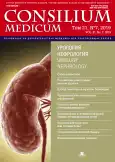Bacteriophages in treatment of low urinary tract infections
- Authors: Vasilyev A.O.1, Zaitsev A.V.1, Kalinina N.A.1, Shiriaev A.A.1, Kim Y.A.1, Pushkar D.Y.1
-
Affiliations:
- Yevdokimov Moscow State University of Medicine and Dentistry
- Issue: Vol 21, No 7 (2019)
- Pages: 38-41
- Section: Articles
- URL: https://journal-vniispk.ru/2075-1753/article/view/96802
- DOI: https://doi.org/10.26442/20751753.2019.7.190511
- ID: 96802
Cite item
Full Text
Abstract
Keywords
Full Text
##article.viewOnOriginalSite##About the authors
Aleksandr O. Vasilyev
Yevdokimov Moscow State University of Medicine and Dentistryканд. мед. наук, ассистент Moscow, Russia
Andrei V. Zaitsev
Yevdokimov Moscow State University of Medicine and Dentistry
Email: alininatalia06@gmail.com
D. Sci. (Med.), Prof. Moscow, Russia
Natalia A. Kalinina
Yevdokimov Moscow State University of Medicine and Dentistry
Email: alininatalia06@gmail.com
Clinical Resident Moscow, Russia
Arsenii A. Shiriaev
Yevdokimov Moscow State University of Medicine and DentistryGraduate Student Moscow, Russia
Yurii A. Kim
Yevdokimov Moscow State University of Medicine and DentistryGraduate Student Moscow, Russia
Dmitrii Yu. Pushkar
Yevdokimov Moscow State University of Medicine and DentistryCorr. Memb. RAS, D. Sci. (Med.), Prof. Moscow, Russia
References
- Rubinstein E, Ronald A.R. Toronto declaration to combat antimicrobial resistance. Proceedings of the Global Resistance Day, 40th Interscience Conference on Antimicrobial Agents and Chemotherapy, Toronto, Ontario, Canada..
- Santajit S, Indrawattana N. Mechanisms of Antimicrobial Resistance in ESKAPE Pathogens. BioMed Res Int 2016; p. 1-8.
- Chanishvili, A. A Literature Review of the Practical Application of Bacteriophages. New York City: Nova Science Publishers, 2012.
- Каверин В.А. Открытая книга. Ч. III. М., 1956. [Kaverin V.A. Open book. Part III. M., 1956 (in Russian).]
- Martin, S.A, Haren M.T. Prevalence and factors associated with uncomplicated storage and voiding lower urinary tract symptoms in community-dwelling Australian men. World J Urol 2011; 29: 179-84.
- Abrams P, Cardozo L, Fall M. The standardisation of terminology of lower urinary tract function: report from the standardisation sub-committee of the international continence society. Neurourol Urodyn 2002; 21: 167-78.
- Kupelian V, Wei J.T, O’leary. Prevalence of lower urinary tract symptoms and effect on quality of life in a racially and ethnically diverse random sample: the boston area community health (BACH) survey. Arch Intern Med 2006; 166: 2381-7.
- Cornu J.N, Ahyai S, Bachmann A. A systematic review and meta-analysis of functional outcomes and complications following transurethral procedures for lower urinary tract symptoms resulting from benign prostatic obstruction: an update. Eur Urol 2015; 67: 1066-96.
- Schneidewind L, Kranz J, Schlager D. Mulitcenter study on antibiotic prophylaxis, infectious complications and risk assessment in TUR-P. Cent Eur J Urol 2017; 70: 112-7.
- Eriksen H.M, Iversen B.G, Aavitsland P. Prevalence of nosocomial infections in hospitals in Norway. J Hosp Infect 2005; 60: 40-5.
- Gould C.V, Umscheid C.A, Agarwal R.K et al. Guideline for prevention of catheter-associated urinary tract infections. Infect Control Hosp Epidemiol 2010; 31 (4): 319-26.
- Поздеев О.К., Федорова Е.Р., Валеева Ю.В. Микробиология. Методическое пособие. Бактериофаги. Учебно-методическое пособие для студентов медицинских вузов. Казань, 2012. @@Pozdeev O.K., Fedorova E.R., Valeeva Iu.V. Microbiology. Toolkit. Bacteriophages. Uchebno-metodicheskoe posobie dlia studentov meditsinskikh vuzov. Kazan', 2012 (in Russian)
- Xu Y, Liu Y, Liu Y et al. Bacteriophage therapy against Enterobacteriaceae. Virol Sinica 2015; 30 (1): 11-8.
- Leitner L, Sybesma W, Chanishvili N et al. Bacteriophages for treating urinary tract infections in patients undergoing transurethral resection of the prostate: a randomized, placebo-controlled, double-blind clinical trial. BMC Urol 2017; 17 (1): 90.
- Paterson D.L. Resistance in gram-negative bacteria: Enterobacteriaceae. Am J Med 2006; 119: S20-28.
- Leverentz B, Conway W.S, Alavidze Z et al. Examination of bacteriophage as a biocontrol method for Salmonella on fresh-cut fruit: a model study. J Food Prot 2001; 64: 1116-21.
- Abedon S.T, Thomas-Abedon C. Phage therapy pharmacology. Curr Pharm Biotech 2010; 11: 28-47.
- Atterbury R.J, Van Bergen M.A, Ortiz F et al. Bacteriophage therapy to reduce Salmonella colonization of broiler chickens. Appl Environ Microbiol 2007; 73: 4543-9.
- Malik R, Chhibber S. Protection with bacteriophage KØ1 against fatal Klebsiella pneumoniae-induced burn wound infection in mice. J Microbiol Immunol Infect 2009; 42: 134-40.
- Tsay R.W, Siu L.K, Fung C.P, Chang F.Y. Characteristics of bacteremia between community-acquired and nosocomial Klebsiella pneumoniae infection: risk factor for mortality and the impact of capsular serotypes as a herald for community-acquired infection. Arch Intern Med 2002; 162: 1021-7.
Supplementary files






